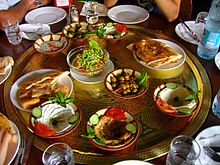Mezze
As mezze or meze is called the way of serving the starters in various countries in the Middle East and surrounding areas. The term is often used in relation to certain foods, but it is not.
In Damascus and other Syrian regions, Lebanon and Turkey , the meze (the small starter plates) are placed in the middle of the table so that the guests can chat while they snack. In addition, typical Arab drinks such as green tea, wine or arak are served in the Arab countries . In Turkey, rakı , wine or Turkish tea is typically served with mezze.
Distribution and names
The origin of the word is said to be in Persian mazze or mazīdan for "taste" or "snack". It has a similar meaning in Turkish . In many of the successor states of the Ottoman Empire and its neighboring states in the Caucasus , this range of dishes or the term, and the tradition associated with it, is widespread.
Here is a selection of names:
- Arabic language area: mezze (مازة or. مزة)
- Turkey, Azerbaijan and Turkish Republic of Northern Cyprus: meze
- Iran: maze ( مزه )
- Bulgaria: mese ( мезе )
- Greece: meze or mezés ( μεζές ), plural mezedes ( μεζέδες )
- Former Yugoslavia: meze or meza ( Cyrillic мезе, меза ).
Variants of preparation
As Mezze in to Arab cuisine entrees generally referred to. Here the kitchens of Turkey and Lebanon had a strong influence on the ingredients and preparation. Typical ingredients are chickpeas , tahini , yoghurt , aubergines , tomatoes , olives and olive oil ; cumin , coriander or sumac are often used intensively as spices . Known Arabic dishes include: Falafel , baba ghanoush , Fattoush , fatteh , Ful , hummus , kibbeh nayyeh , Kibbeh , mutabbal , tabbouleh , tahini .
In Turkey, meze is a plate that contains very specific dishes. This plate can serve as a snack, but also as a salad substitute as a starter. The meze plates include the following dishes: Arnavut ciğeri , Dolma , Haydari , Muhammara , Tarator , Cacık , Biberli Yoğurt Salatası, Babagannuş and Tarama . This always includes watermelon and a Turkish cheese - Beyaz Peyniri .
In Greece meze are generally less common. There the mezedopoleia ( μεζεδοπωλεία ) have established themselves, catering establishments that have specialized in the sale of typical mezes. There are still the same dishes as in the times of the Ottoman Empire, as these were common throughout the empire.
In Cyprus , meze is a typical national dish that provides a cross-section of the culinary specialties of Cyprus. A distinction is also made there between meze, which mainly consists of meat dishes, and “fish meze”, which consists of various fish dishes. In Cyprus nor the own cheese, which is often Halloumi (Greek.) Or Hellim (Turk.) Served.
In former Yugoslavia and Bulgaria , meze is a kind of cold buffet . This usually consists of ham, bacon and sausage, boiled eggs, vegetables (often pickles) and ajvar or kajmak as well as various types of cheese ( sheep cheese , kačkavalj ...).
Web links
Individual evidence
- ^ Sarah Maxwell: Greek Meze Dishes . Könemannverlag, 1999, ISBN 3-89508-115-9
- ↑ Oxford English Dictionary , online version, June 2011
- ↑ μεζεδοπωλείο . Greeklex.net
